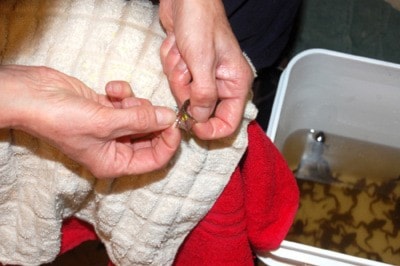A team of biologists and students spent the better part of a recent Friday tagging 150 endangered frogs before they were released into the wild.
For over a decade the Greater Vancouver Zoo has been involved with the recovery project of the Oregon Spotted Frog, since this species was declared endangered in 1999.
The biologists marked the frogs for identification and tracking purposes, and then released the sub-adults back into the wild.
The frogs were once abundant in the Pacific Northwest, ranging from southwestern B.C. to the northern tip of California. The Oregon Spotted Frog population in B.C. is estimated to be less than 350 breeding individuals in 2010, and is now restricted to three scattered wetland locations in the Fraser River Lowlands.
Environment Canada biologist Rene McKibbin said the frogs were “common everywhere in the 1960s” but development and habitat changes have drastically reduced their numbers.
However, “They have started breeding in captivity and that’s a good sign. In the wild only about one per cent survive but in captivity it’s 60 to 70 per cent.”
The frogs that were marked were from the Vancouver Aquarium’s batch of eggs from last year. There have been no eggs found at the Aldergrove site at the former Navy Base land since 2007.
The zoo has been rearing the tadpoles in large 1,350 litre (300 gallons) tanks in which the tadpoles develop and grow. These tanks are kept in a heated indoor facility in the winter and outdoors in the summer.
Zoo keepers care for the developing frogs by raising crickets, the frogs’ main food, along with a pureed lettuce mixture and bloodworms, and by feeding the animals and periodically changing the tank water.
Zoo keeper Cindy Hulst said that she’s seen a drastic decline in the frog population since she started working with the program 14 years ago.
“I hope we can find new designated site for release into the wild, too.”
The Oregon Spotted Frogs are medium-sized and named for the black blotches with light centres that are distributed across the head and back of adult frogs. These spots become larger and ragged looking around the edges as the frog ages. They also have a pair of parallel, light brown to orange ridges which are called dorsolateral folds that run from just behind the eyes all the way down their back.
Juveniles are light brown or olive green on their back and white to cream on their belly. Their mating call consists of a series of 5-50 clucks that sound like knocking on a log, or someone softly clicking their tongue on the roof of their mouth.
The Oregon Spotted Frog Recovery team was formed in 1999 when the Committee on the Status of Endangered Wildlife in Canada (COSEWIC) first designated the frog as “endangered”, in order to save the species. The species is also red-listed in B.C. The team is comprised of biologists from provincial and federal government agencies, members of CAZA (Canadian Association of Zoos & Aquariums) and other researchers.
